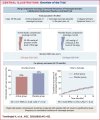Get Access
Original Research
4 August 2025
Using Compression Stockings to Prevent Recurrence of Vasovagal Syncope:
Authors:
Hamed Tavolinejad,
Ali Bozorgi,
Zahra Emkanjoo,
Alireza Oraii,
Javad Shahabi,
Reza Mollazadeh,
Mohamadreza Kiarsi, … Show All … , and
Masih Tajdini mtajdin1@jh.eduAuthors Info & Affiliations
Publication: JACC
Volume 86, Number 6
https://www.jacc.org/doi/10.1016/j.jacc.2025.05.049#
Abstract
Background
Vasovagal syncope (VVS) is a common yet challenging condition with limited effective treatments. Elastic compression stockings (ECS) have been proposed as a potential therapy, but their real-world effectiveness remains unclear.
Objectives
This study sought to compare the effectiveness of lower extremity compression with thigh-high ECS vs sham stockings for the prevention of VVS recurrence.
Methods
This multicenter, parallel, blinded, randomized sham-controlled trial enrolled adults 18 to 65 years of age with ≥2 VVS episodes in the past year. Participants were randomized 1:1 to receive either thigh-length, open-toe active ECS (25-30 mm Hg pressure to the leg), or identical-looking sham ECS (≤10 mm Hg pressure). All participants received standard care (education and lifestyle modifications) but no medications for preventing VVS recurrence. ECS adherence was tracked using diary booklets. The coprimary outcomes were: 1) the proportion of participants with ≥1 VVS recurrence; and 2) the time to first VVS recurrence (ie, VVS-free survival).
Results
Among 266 participants (mean age 39 years, 58% female), during 12 months of follow-up, VVS recurred in 29.1% (n = 39 of 134) of participants in the treatment group and 34.8% (n = 46 of 132) in the control group (absolute risk reduction: 5.7%;
P = 0.315). VVS-free survival was not significantly different (HR: 0.81; 95% CI: 0.53-1.24;
P = 0.333). ECS adherence was suboptimal, with discontinuation rates of 37.3% in the treatment arm vs 34.8% in the sham arm. Discontinuation rates, duration of using ECS, and adherence rates were similar between treatment groups. The median number of recurrent episodes was similar (treatment: 2.5 vs sham: 2;
P = 0.839). However, significantly fewer VVS episodes occurred while actively wearing ECS (32.7% vs 45.1%;
P = 0.024).
Conclusions
Treating syncope with thigh-high lower limb compression using ECS did not reduce the cumulative incidence of VVS recurrence, and did not change VVS-free survival. Additionally, ECS did not reduce the frequency of multiple VVS episodes. The results do not support routine use of thigh-length ECS, although it may be helpful for selected patients when added to standard care. Because our study specifically tested thigh-high ECS, future studies should aim to assess the effectiveness of more extensive compression targeting pelvic and abdominal venous pooling.

